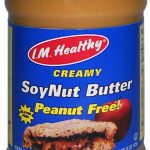The ongoing outbreak of E. coli O157:H7 illnesses linked to recalled I.M. Healthy SoyNut Butter has sickened at least 12 people in five states, most of them children. Because the product is a peanut butter substitute, it was served in daycare centers and in schools. So how does pathogenic bacteria get into a ready to eat product? This shelf stable, ready to eat product is considered benign by most people. But there have been large outbreaks linked to nut butter products in the past, most notably the 2008 Salmonella outbreak linked to the Peanut Corporation of America (PCA) that sickened at least 700 people. There have been more than 90 recalls of nut butters and nuts for bacterial contamiantion since 2001 in this country. Most of the recalls have been issued since 2012. So how … [Read more...]
FDA Weighs in on I.M. Healthy SoyNut Butter E. coli O157:H7 Outbreak
The FDA has issued information about the E. coli O157:H7 outbreak linked to I.M. Healthy SoyNut Butter that has sickened at least 12 people in 5 states. Six of those patients have been hospitalized. And four people have developed hemolytic uremic syndrome (HUS), a potentially life-threatening complication of this infection. On March 3, 2017, the SoyNut Butter Company recalled its I.M. Healthy Original Creamy SoyNut Butter with two best by dates. On March 4, 2017, they expanded the recall to include product packed in different sizes and more best by dates. But the CDC and FDA are warning consumers not to eat any I.M. Healthy SoyNut Butter products, including granola coated with the Butter, until further notice. The outbreak case count by state is: Arizona, (4), California (4), … [Read more...]
I.M. Healthy SoyNut Butter Recall Expands After E. coli Outbreak
The SoyNut Butter Company of Glenview, Illinois issued a recall of two Best By dates of its I.M. Healthy Original Creamy SoyNut Butter late last week after the product was linked to an E. coli O157:H7 outbreak that sickened at least 12 people in 5 states. Today, they expanded that recall to include more products and one more Best By date. The product was sold at the retail level in multiple states. It was also distributed to childcare centers and schools in many states. The I.M. Healthy Original Creamy SoyNut Butter is packaged in 15 ounce plastic jars with the Best By dates July 5, 2018, August 30, 2018, and August 31, 2018. It is also available for sale in individual portion cups with the Best By date August 8, 2018, and in 4 pound plastic tubs with Best By dates of November 16, … [Read more...]
Some I.M. Healthy SoyNut Butter Recalled after E. coli Outbreak
The SoyNut Butter Company is voluntarily recalling their I.M. Healthy Original Creamy SoyNut Butter with the Best By dates of 8-30-18 and 8-31-18. This recall is in response to the FDA's investigation of an E. coli O157:H7 outbreak that has sickened at least 12 people in five states. The press release from the company states that this recall does not affect any other I.M. Healthy products. However, the CDC, FDA, and the state governments of Arizona, California, and Maryland are telling consumers not to eat any I.M. Healthy SoyNut Butter products, including their SoyNut Butter coated granola, until more information about the outbreak is available. These products have a long shelf life and are in consumers' homes. If you purchased any I.M. Healthy SoyNut Butter products, do not eat … [Read more...]
California Hit Hard by I.M. Healthy SoyNut Butter E. coli Outbreak
The California Department of Public Health (CDPH) warned consumers, especially children, not to eat I.M. Healthy brand SoyNut Butter or granola coated with SoyNut Butter, because they may be contaminated with E. coli O157:H7 bacteria. The CDPH, along with the CDC and FDA, are investigating a multistate outbreak of Shiga toxin-producing Escherichia coli infections linked to those products. As of March 2, 2017, 12 patients have been identified in this outbreak. Four of those patients live in California. Most of the patients in this outbreak have been children, which explains why the hospitalization rate and the percentage of patients with hemolytic uremic syndrome (HUS) have been so high. Six of the twelve patients have been hospitalized. Four of them have developed HUS. All four … [Read more...]








